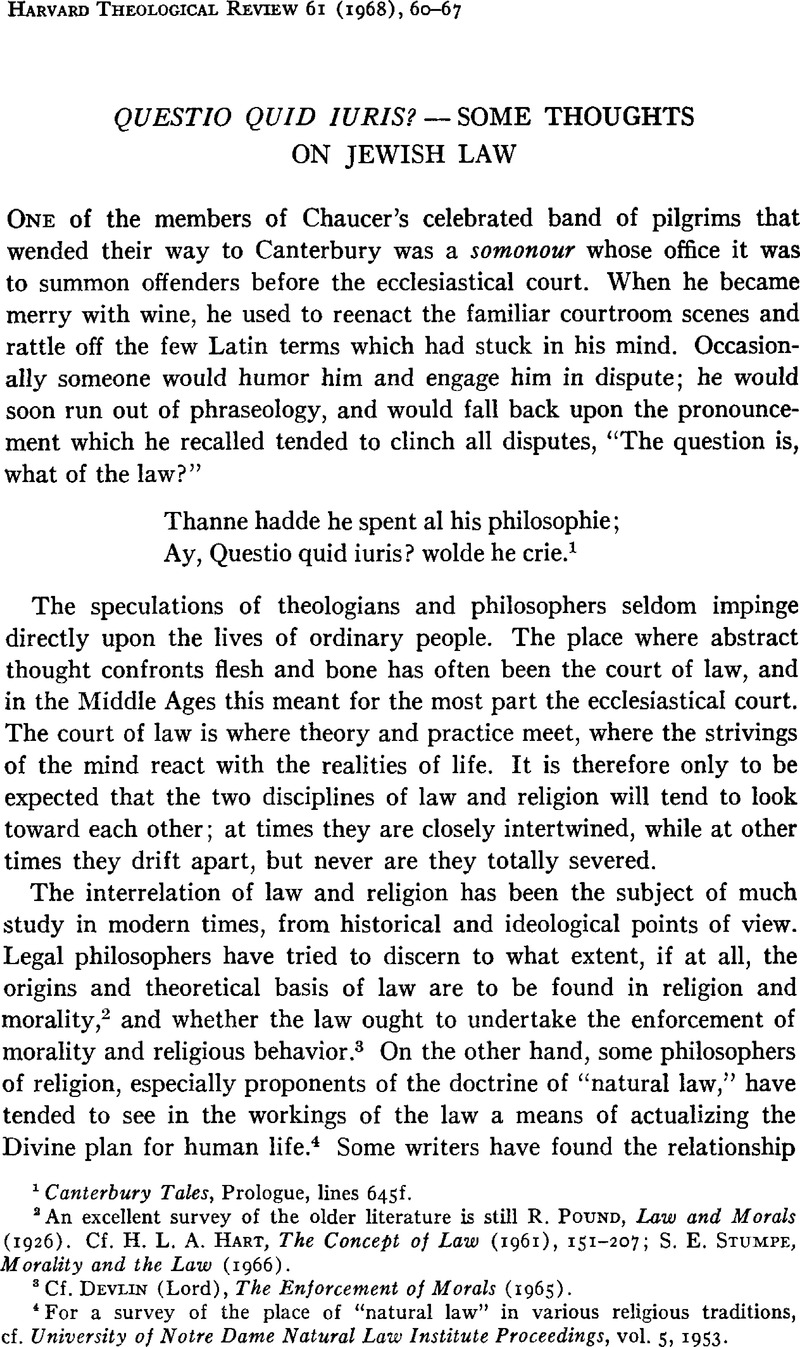No CrossRef data available.
Article contents
Questio quid Iuris? — Some Thoughts on Jewish Law
Published online by Cambridge University Press: 10 June 2011
Abstract

- Type
- Notes & Observations
- Information
- Copyright
- Copyright © President and Fellows of Harvard College 1968
References
1 Canterbury Tales, Prologue, lines 645f.
2 An excellent survey of the older literature is still R. Pound, Law and Morals (1926). Cf. H. L. A. Hart, The Concept of Law (1961), 151–207; S. E. Stumpe, Morality and the Law (1966).
3 Cf. Devlin (Lord), The Enforcement of Morals (1965).
4 For a survey of the place of “natural law” in various religious traditions, cf. University of Notre Dame Natural Law Institute Proceedings, vol. 5, 1953Google Scholar.
5 The principal views are summarized in G. W. Paton, A Textbook of Jurisprudence, 51f. See also W. Seagle, The History of Law, 117–30.
6 F. Schulz, Roman Legal Science, 15–37.
7 Cf. Daube, D., Tulane Law Review 18 (1944), 351—70Google Scholar.
8 Cf. Guttman, J., Philosophies of Judaism (London, 1964), 18–43Google Scholar.
9 Schulz, op. cit., 32.
10 Cf. Vinogradoff, P., Outlines of Historical Jurisprudence, vol. II (1922), 1–12Google Scholar.
11 The place of supremacy which the law occupied in the life of medieval Jewry has been masterfully surveyed by Baron, S., A Social and Religious History of the Jews, 2nd ed., vol. VI (1958), 3–151Google Scholar.
12 Cf. the recent discovery of some of his legal works by Margaliot, M., Sefer Hilkot Ha-Naggid (Jerusalem, 1962)Google Scholar.
13 Cf. R. J. Z. Werblowsky, Joseph Karo, Lawyer and Mystic (1962).
14 In Zeitschrift für vergleichende Rechtswissenschajt 27 (1912), 404—24Google Scholar. Further literature on this question is cited by Cohen in the work cited below at note 20, at p. xxv.
15 Toledoth Ha-Halakah, 2nd ed. (New York, 1945)Google Scholar.
16 Leheker Toledoth Ha-Mishpat Ha'Ibri (Jerusalem, 1929)Google Scholar; Toledoth Ha-Mishpat beYisrael (Jerusalem, 1939)Google Scholar.
17 Cf. Kisch, G., Research in Medieval Legal History of the Jews, in Proceedings of the American Academy for Jewish Research, VI (1936), 229–76Google Scholar.
18 E.g., R. Yaron, Gifts in Contemplation of Death in Jewish and Roman Law (1960); Z. W. Falk, Jewish Matrimonial Law in the Middle Ages (1966); S. Albeck, Pesher Dine HaNezikin BaTalmud (1965).
19 Cf. J. Badi, The Government of the State of Israel (1963), 245–57; Chigier, M., The Rabbinical Courts in the State of Israel, in Israel Law Review, vol. 2, no. 2 (April, 1967), 147–81Google Scholar.
20 Cohen, Boaz, Jewish and Roman Law, A Comparative Study (New York, 1966), 2 volsGoogle Scholar.
21 Cohen, op. cit., 187ff.
22 Kontres Ha-teshubot (Budapest, 1930)Google Scholar.




